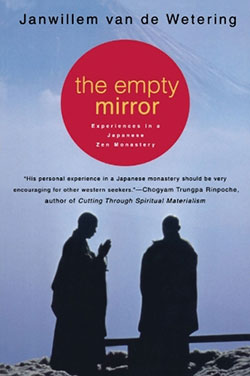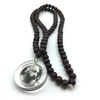The Empty Mirror

Kaiyum reviews this very insightful and inspiring real-life book by Janwillem van de Wetering; “The numerous Zen stories are a delightful reminder of the clarity and simplicity of this approach to enlightenment and spiritual freedom.”
Period: the early 1950s
Location: Kyoto, Japan
Destination: a Zen monastery
Hero: Janwillem van de Wetering
Purpose: to discover the meaning of life, the ‘absolute truth’
This young man from Rotterdam (the Netherlands) has enough money from an inheritance to live frugally for about three years. He arrives by boat at Kobe, finds his way to the monastery in Kyoto, where he makes his first blooper: he rings the large bell hanging at the gate. The story continues with how he is received and by whom. Every detail is described with the freshness of perception associated with being in situations that are radically different to anything previously encountered.
The writer
Van de Wetering (12 February 1931 – 4 July 2008) is a colourful character with a zest for life and adventure. Born and raised in Rotterdam, he later lived in South Africa, Japan, London, Columbia, Peru, Australia, even lived for a while in Amsterdam, but spent his latter years in Maine (USA), where he also died.
A prolific writer, he is best known for his detective novels, based on his work with the Amsterdam Special Constabulary. His works include children’s books, translations and a biographical appraisal of the Dutch diplomat, author and orientalist, Robert Van Gulik.
During his 18 months in Japan, he studied Zen under the guidance of Oda Sessō at Daitoku-ji for a year, and spent the other six months outside the monastery with the character ‘Peter’ (an American Zen adept called Walter Nowick), adhering to some extent to a meditative regime agreed upon with his host, Peter.
Getting going
A philosophy professor in London gives him a list of some twenty books to read. Van de Wetering describes an exchange in the corridor that initiates the voyage to Japan to pursue ‘the absolute truth’:
What you have is what all mystics have had, and the only way to resolve it is to follow a mystical training. Get yourself off to a monastery, that’ll do the trick.
Twenty years or so later, this young man would probably have got caught up in the trickle of Westerners that turned to India as the source of possible answers, a trickle that turned into a flood as the 1970s progressed.
Recognition
Those readers who have ever participated in an ‘Enlightenment Intensive’ will recognise the strict regime, the intense focus on the koan and the structures that Van de Wetering encounters. He describes in uncomfortable detail the agonies of sitting, of gradually getting his stiff Western body to approximate the lotus posture, of keeping clean, of getting enough nourishing food and sleep, of keeping warm during sesshin… Yet Van de Wetering does not get any glimpse of satori, neither does all his thinking get him closer than ‘the empty mirror’ in understanding what Zen is all about.
Entertaining
The numerous encounters with various Westerners – Peter, Gerald, the wealthy gay businessman Leo – contribute to this easy, enjoyable read. The interactions with other ‘inmates’ of the monastery provide fascinating insights into a way of life that contrasts significantly with Western norms. The numerous Zen stories are a delightful reminder of the clarity and simplicity of this approach to enlightenment and spiritual freedom. All in all, this book, although it dates from the early 1950s, is in no way dated and is a pleasant source of worthwhile distraction.
Available at amazon.com – amazon.co.uk – amazon.de – amazon.in
Kaiyum is a regular contributor
All articles by this author published on Osho News
- Log in to post comments
- 18 views
